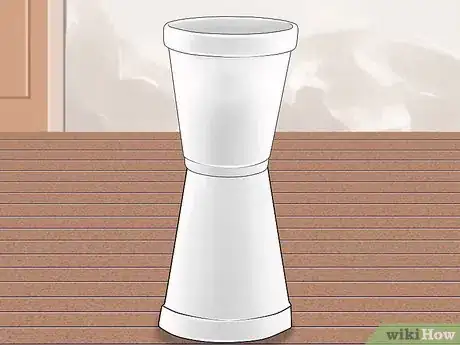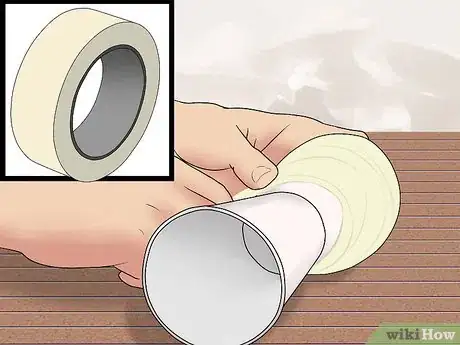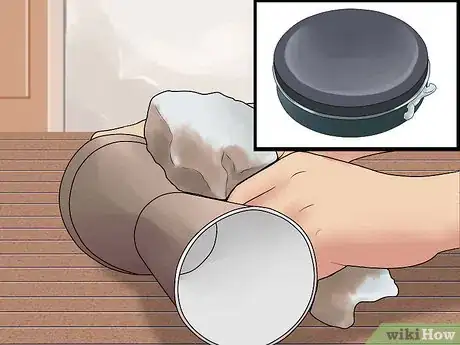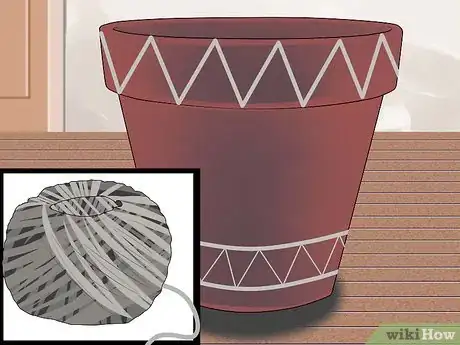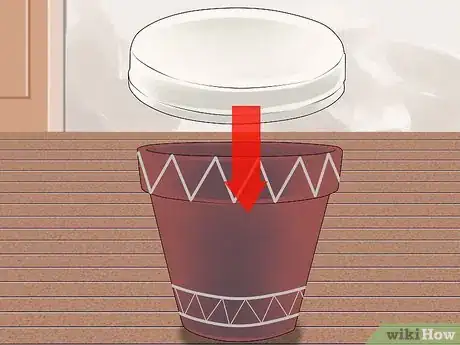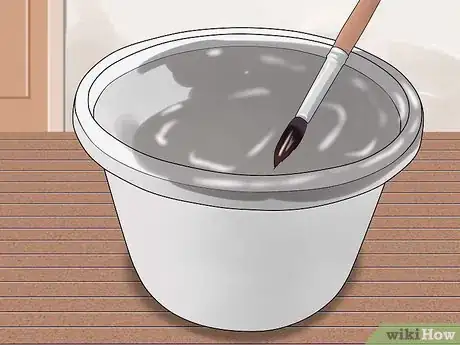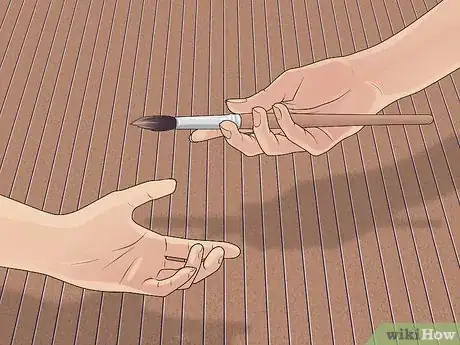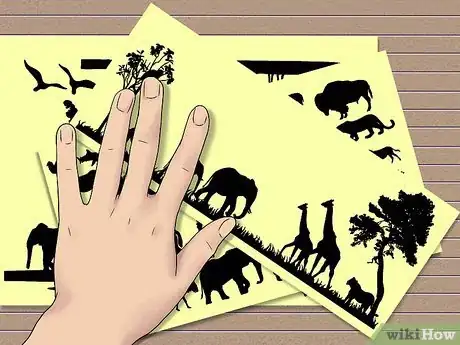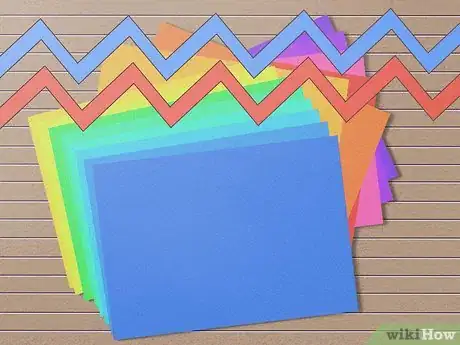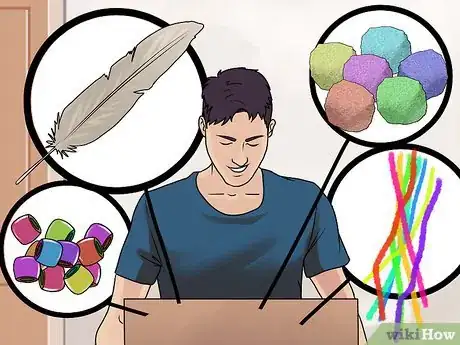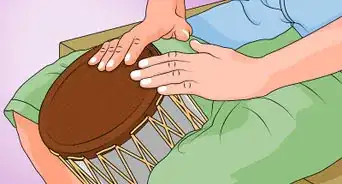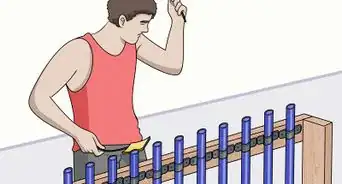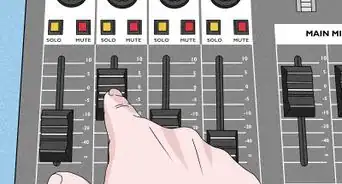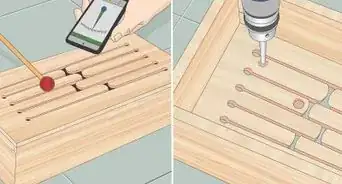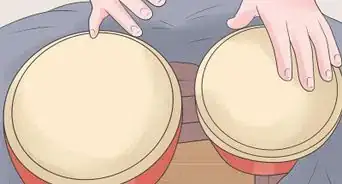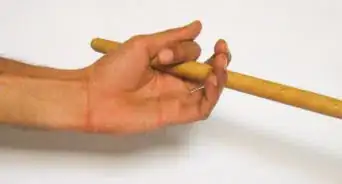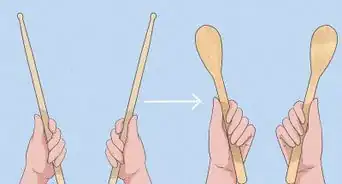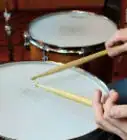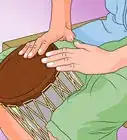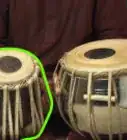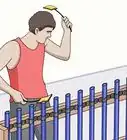This article was co-authored by wikiHow Staff. Our trained team of editors and researchers validate articles for accuracy and comprehensiveness. wikiHow's Content Management Team carefully monitors the work from our editorial staff to ensure that each article is backed by trusted research and meets our high quality standards.
This article has been viewed 88,841 times.
Learn more...
An African drum is a portable instrument. Often called a djembe drum, an African drum can provide background rhythm for other instruments, or can be used as the main instrument in making music. Making an African drum can be a fun activity for young children. There are a variety of methods you can use to make your own African drum.
Steps
Using Disposable Cups
-
1Gather your supplies. You can make a simple African drum using disposable cups. This is an easy and non-messy activity that is great for very young children. First, you'll need to gather the necessary supplies.
-
2Glue the cups together. The first step is to glue the cups together. Apply a generous amount of glue to the bottom of each cup. Stick the bottoms together, hold until secure, and then let dry.[3]
- If you're doing this activity with kids, they should be able to manage this step on their own. However, if you're working with a large group of children it may be easier to prepare the cups yourself ahead of time. Young kids especially may be impatient waiting for their cups to dry and want to hurry into to the decorating process.[4]
Advertisement -
3Cover the cups in masking tape. Once you have the cups prepared, cover them in masking tape. This creates a surface on which children can color and decorate the cups.
-
4Add shoe polish. Now, you'll add the shoe polish. This will give your project a color similar to a traditional African drum. Use your paintbrush to brush a layer of shoe polish over the masking tape. Then, take a clean rag and wipe off excess polish. Allow the drums to sit until they're dry to the touch before use.[7]
- If you're working with kids, use your judgment regarding shoe polish. If you feel your kids are old enough to handle applying it on their own, allow them to do so with supervision. Very young children, however, may make a mess when using shoe polish.
- If you decide to let your kids apply the polish alone, have them wear old clothing or provide them with smocks. Shoe polish can smear easily.
Trying a Garden Pot
-
1Gather your supplies. For a sturdier drum, you can use a garden pot or planter pot. This activity requires a bit more skill. It might be fun to use with slightly older children. To begin, gather the necessary supplies.
- You will need a garden pot or planter made with a terra-cotta covering. It should have a seven inch diameter. You should be able to find this at a local gardening or craft shop.[8]
- You will need a plastic lid big enough to fit over the pot. You can use a disposable food storage lid.[9]
- You will also need another lid that goes with a sturdy plastic container. The pot should be able to sit comfortably on this container. You can buy a plastic container at a local craft shop. However, you can also use a deli container or a takeout container for soup.[10]
- You will also need dry beans, twine or string, medium weight twine, a glue gun, craft glue, and brown acrylic paint.[11]
-
2Make a zig-zag pattern around your terra cotta pot using twine. To start, loop the twine around the planter in a zig-zag pattern. To do this, use the glue gun to add a dab of glue to the top and bottom of the string on the points forming the zig-zag. Press down on the string for a few seconds after applying glue to make sure it stays in place.[12]
- If you're working with a child, help him during this process. It can be helpful to show him zig-zag patterns online to get a sense of what he should be creating. A child should not operate a glue gun without supervision. If your child is very young, it's best to operate the glue gun yourself.
-
3Add the top of the drum. Once the zig-zag pattern is created, you can add the top of the drum. To do this, you'll need your plastic lid.
-
4Paint the plastic container. The plastic container will form the bottom of your drum. This should be painted brown to match the pot. You can have your child paint the container or you can do so yourself if your child is too young. Allow the container to dry completely before continuing. How long the drying process takes depends on how much paint you used and the specific brand.[15]
-
5Create the base of the drum. Once the paint is dry, you can create the base of your drum. To start, apply glue to the bottom of the planter. Use a generous amount. Press the bottom of the plastic container against the bottom of the planter. Hold until secure.[16]
- From here, fill the container at the bottom with dry beans. this will weigh down the drum, allowing it to be more stable when played. Seal the container with the lid when you're finished.[17]
Decorating Your Drum
-
1Learn about the appearance of a Djembe drum. A Djembe drum is typically goblet shaped. The top is usually made with goatskin and traditionally made from wood. Ropes usually tie the goatskin in place, holding it down in a somewhat zig-zag pattern. The shoe polish on the cup design and the terra cotta pot and painted containers in the pot design both imitate the wood covering of a Djembe drum. If you did the terra cotta design, you'll already have made some zig-zags. If you're using cups, you can draw or paint on zig-zags to mimic an authentic design. This will get you started in terms of making realistic designs.[18]
-
2Familiarize yourself with symbolic decorations. There are certain carvings you may find on traditional African drums. These can represent different aspects of life and culture in different parts of Africa. You can try adding such designs using stickers, paint, or other craft supplies to make your project more authentic.
- Various animals may represent different things on a drum. A crocodile is considered one of the first creatures on earth in some African cultures, for example. A python is often associate with divination and fortune-telling. Chickens can represent possibility and sacrifice. Fish can represent wealth and happiness.[19]
- A padlock can represent power and control. Some occupations also hold significance. Drawing a blacksmith, or a blacksmith's tools, on your drum can symbolize transformation or fire.[20]
- Keep in mind symbolism varies from culture to culture. You might want to get a sense of how symbolism is used and then use symbols from your own personal life and culture on your drums. For example, if a particular animal has special symbolism to you, you could put that on your drum.
-
3Provide markers and paint. You can add decorations by simply using paint and markers. This may be the simplest option when working with young children.
- Both masking tape and terra-cotta are easy to paint or draw on with markers. With the terra-cotta project, beads of glue from the zig-zagging process may be visible. These can be covered up with the use of paint or markers.[21]
- When working with children, provide smocks or have your kids wear old clothing. Paint and markers can get messy.
-
4Use stickers. If you're doing any of the above projects with very young children, consider providing them with stickers. These may be easier to use. Look for African-themed stickers, such as stickers featuring animals you would find in the region. You may be able to find stickers involving countries from Africa online. These can help make the project educational.
-
5Consider construction paper. Construction paper can also be a fun addition to an African drum project. You can have your kids cut the paper into shapes and glue them onto their pots or cups. Construction paper can make a variety of fun patterns that can be added to the African drums.
-
6Throw in other craft supplies. You can stop by a local craft store and pick up things like beads, feathers, puffballs, pipe cleaners, and other fun craft accessories. If you're working with young children, they'll have fun gluing such supplies to their drums. Young kids often appreciate getting a little zany or silly for their projects. Don't be afraid to think outside the box by providing a medley of fun craft supplies.
References
- ↑ http://www.dltk-kids.com/world/africa/mdrum.htm
- ↑ http://www.dltk-kids.com/world/africa/mdrum.htm
- ↑ http://www.dltk-kids.com/world/africa/mdrum.htm
- ↑ http://www.dltk-kids.com/world/africa/mdrum.htm
- ↑ http://www.dltk-kids.com/world/africa/mdrum.htm
- ↑ http://www.dltk-kids.com/world/africa/mdrum.htm
- ↑ http://www.dltk-kids.com/world/africa/mdrum.htm
- ↑ http://www.education.com/activity/article/african-djembe-drum/
- ↑ http://www.education.com/activity/article/african-djembe-drum/
- ↑ http://www.education.com/activity/article/african-djembe-drum/
- ↑ http://www.education.com/activity/article/african-djembe-drum/
- ↑ http://www.education.com/activity/article/african-djembe-drum/
- ↑ http://www.education.com/activity/article/african-djembe-drum/
- ↑ http://www.education.com/activity/article/african-djembe-drum/
- ↑ http://www.education.com/activity/article/african-djembe-drum/
- ↑ http://www.education.com/activity/article/african-djembe-drum/
- ↑ http://www.education.com/activity/article/african-djembe-drum/
- ↑ http://www.drumafrica.co.uk/articles/the-djembe/
- ↑ http://creativity.denverartmuseum.org/?lesson-plan=drums-of-africa
- ↑ http://creativity.denverartmuseum.org/?lesson-plan=drums-of-africa
- ↑ http://www.education.com/activity/article/african-djembe-drum/

